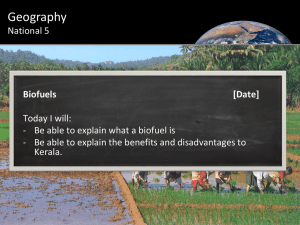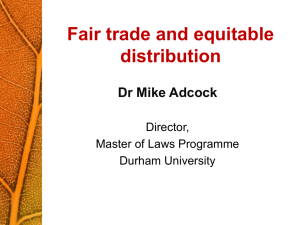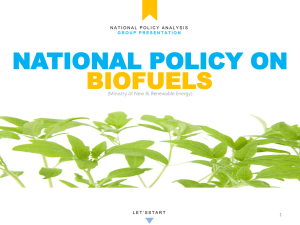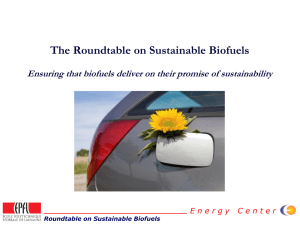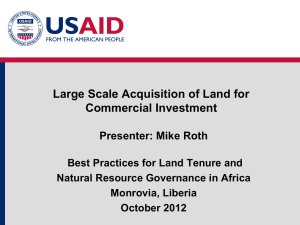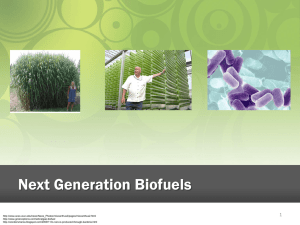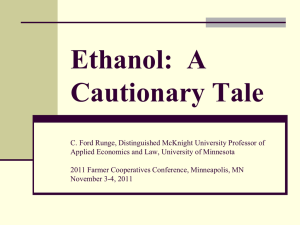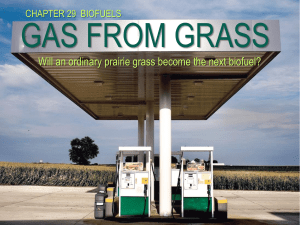Biofuels: the illusion and the reality
advertisement
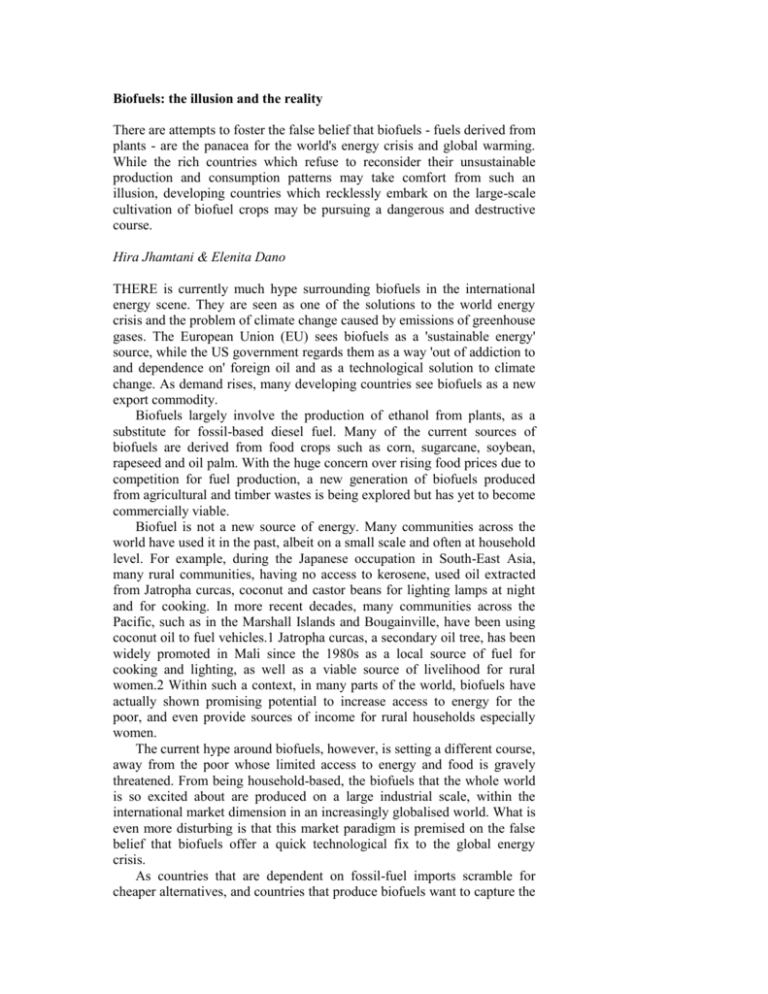
Biofuels: the illusion and the reality There are attempts to foster the false belief that biofuels - fuels derived from plants - are the panacea for the world's energy crisis and global warming. While the rich countries which refuse to reconsider their unsustainable production and consumption patterns may take comfort from such an illusion, developing countries which recklessly embark on the large-scale cultivation of biofuel crops may be pursuing a dangerous and destructive course. Hira Jhamtani & Elenita Dano THERE is currently much hype surrounding biofuels in the international energy scene. They are seen as one of the solutions to the world energy crisis and the problem of climate change caused by emissions of greenhouse gases. The European Union (EU) sees biofuels as a 'sustainable energy' source, while the US government regards them as a way 'out of addiction to and dependence on' foreign oil and as a technological solution to climate change. As demand rises, many developing countries see biofuels as a new export commodity. Biofuels largely involve the production of ethanol from plants, as a substitute for fossil-based diesel fuel. Many of the current sources of biofuels are derived from food crops such as corn, sugarcane, soybean, rapeseed and oil palm. With the huge concern over rising food prices due to competition for fuel production, a new generation of biofuels produced from agricultural and timber wastes is being explored but has yet to become commercially viable. Biofuel is not a new source of energy. Many communities across the world have used it in the past, albeit on a small scale and often at household level. For example, during the Japanese occupation in South-East Asia, many rural communities, having no access to kerosene, used oil extracted from Jatropha curcas, coconut and castor beans for lighting lamps at night and for cooking. In more recent decades, many communities across the Pacific, such as in the Marshall Islands and Bougainville, have been using coconut oil to fuel vehicles.1 Jatropha curcas, a secondary oil tree, has been widely promoted in Mali since the 1980s as a local source of fuel for cooking and lighting, as well as a viable source of livelihood for rural women.2 Within such a context, in many parts of the world, biofuels have actually shown promising potential to increase access to energy for the poor, and even provide sources of income for rural households especially women. The current hype around biofuels, however, is setting a different course, away from the poor whose limited access to energy and food is gravely threatened. From being household-based, the biofuels that the whole world is so excited about are produced on a large industrial scale, within the international market dimension in an increasingly globalised world. What is even more disturbing is that this market paradigm is premised on the false belief that biofuels offer a quick technological fix to the global energy crisis. As countries that are dependent on fossil-fuel imports scramble for cheaper alternatives, and countries that produce biofuels want to capture the potential market share, the illusion is being fostered that our current unsustainable production and consumption patterns of life can be sustained by clean biofuels instead of expensive and more pollutive fossil fuels. The emphasis is on fulfilling the tremendous demand of industries and the industrialised nations. This development gives rise to some key concerns in developing countries and the rest of the world. Food-security issues The current biofuels are mostly produced from grain food crops such as soybean, corn and groundnuts and non-grain food crops such as cassava, sugarcane, oil palm and rapeseed. Other plants such as jatropha and pongamia are tree crops that have been underutilised in the past but are now receiving enormous attention for their commercial potential. Thus, competition between biofuel and food supply is expected to manifest itself at two levels: agricultural resources and price. Competition for land and agricultural resources. Large-scale cultivation of crops for biofuel will trigger new competition for agricultural resources, and/or will increase existing competition, mainly for land and water, between food production and biofuel production. More agricultural lands would have to be set aside for biofuel production, especially for grain and other food crops, to meet the increasing demand and thus control spiralling prices. The problem is, the world already has little land to spare for growing food, let alone bioenergy crops.3 Even with the strategy to focus more on non-grain oil crops such as jatropha, which can even grow in marginal lands, massive production would require conversion of agricultural and forest lands to grow these crops on a commercial scale. Satellite data reveal that 40% of the earth's land is already used up for agriculture. Estimates show that more than one-third of all agricultural lands would need to be converted to biofuel production in order to raise its share in domestic consumption of transport fuels to 10%. Increased production of biofuels on a commercial scale and expansion of agricultural areas will substantively increase the demand for water for agricultural purposes, which is already consuming 93% of the world's available fresh water supply and benefiting from 66% of the world's total water withdrawals4. Already, the amount of water required for food production is projected to increase from 60 to 90% in the next 50 years, especially if there is no improvement in water productivity.5 Add to that figure the demand for biofuels production and the consequences of climate change on the world's water supply and distribution, and the world should brace itself for another global crisis in the offing. In the competition between food and fuel, the poor, who have limited access to and control over land and who have to fight for water in many cases, are bound to lose. Rising food prices. Food crops, particularly grains, are expected to be produced more for biofuel than for food or feedstocks. While price segmentation in the international commodities market may not be an issue, increased demand for the same produce that is largely sold as food or feedstock would naturally jack up its price. Sugar prices have doubled (driven in part by Brazil's use of sugarcane for fuel), and world corn and wheat prices were up one-fourth in 2006. It is projected that by 2020, the increasing demand for biofuels, at current rates of expansion, may push up the price of wheat by as much as 30%, corn by 41% and oilseeds by 76%.6 The grim projections on the impact of massive demand for biofuels on food prices are already borne out in reality. In Mexico, for example, the expanding cropland planted to yellow corn for ethanol, exported to the US, has reduced the supply of white corn for tortillas7. The high cost of white corn and tortillas, the food staple of poor Mexicans, is causing social unrest in Mexico, prodding the government to declare a ceiling on the price of tortillas.8 In 2006, the US Department of Agriculture reported that world grain consumption will increase by 20 million tons. Of that, 14 million tons will be used to fuel cars in the US, leaving only six million tons to cover the world's growing food needs. The price of corn, the staple diet of many South Africans, also increased in 2006, and diversion of corn to produce fuel or to be exported to feed the biofuel markets of the US and the EU will further increase its price, as predicted by the NGOs CURES and Earthlife Africa.9 Similarly, the joint announcement by Malaysia and Indonesia about allocating 40% of their combined annual palm oil output for biodiesel production, could increase the price of edible oil, making it expensive for both food and energy users10. Measures to ensure that ethanol production will not compete with food production, such as the required distances between sugar mills for food/feedstock production and biofuels processing adopted by the Philippine government, are mere palliatives in view of the market forces commanding higher prices due to massive increases in the demand for sugarcane worldwide. For the world's poorest people, many of whom spend half or more of their income on buying food, rising grain prices can quickly become lifethreatening11. Higher food prices would further marginalise the world's poor, whose fundamental access to food is often challenged by any fluctuations in food supply, demand and prices. It will divert local carbohydrate and protein sources for people to the energy market. High costs of feedstock will drive small livestock and poultry raisers out of business, depriving millions of poor families of their livelihood sources. The increased income that farmers are projected to gain from higher prices for their harvests if they plant crops for biofuels will be offset by the high prices of food that most need to buy to feed their families, as most farmers working in plantations and those involved in cultivation of commercial crops are considered food-deficit. Food security under threat. With the hype over biofuel production still heating up, what's at stake in the end is world food security. The oftrepeated statement that the world is producing twice the daily food requirement of its current population may not hold true for long, with biofuels emerging as a voracious competitor. With dismal food distribution systems and the highly unequal access to food, the world's poor are bound to suffer most from the consequences of massive production of biofuels. Shifting to non-food crops does not provide an answer since growing long-neglected oil crops such as the much-vaunted jatropha would not ease the pressure on the world's land and water resources. The promises of the 'second-generation biofuels' derived from agricultural and forest wastes remain a long shot, not to mention their other potential consequences. In such a context, the world will have to live with the present reality where biofuels production competes with food production and leaves negative impacts on the price of food - bearing disastrous consequences for world food security which could lead to social unrest. All these in the name of quenching the thirst for fuel of industrialised countries and the world's elite moving around in their four-wheel-drive vehicles. Environmental issues Biofuels have been promoted as a 'clean' energy source. But analysis on their efficiency and life-cycle from production to use to emission tends to show otherwise. Unfortunately, the overall environmental impacts of biofuel production have largely been ignored in the excitement over its promise as a 'clean' alternative to dirty fossil fuels. Commercial biofuel production in fact requires more fossil fuel. The biofuel energy balance - the amount of fossil energy put into producing crop biomass compared to that coming out - is anything but promising. Researchers Patzek and Pimentel see serious negative energy balances with biofuels. Other researchers see only 1.2 to 1.8 returns, for ethanol at best, with the jury still lukewarm on cellulosic biofuels12. Ironically, industrialscale production of biofuels would still depend on fossil fuel to keep the processing plants working and to keep the trucks and tankers running to transport the end products to the market. In the most pessimistic analysis, whatever savings in greenhouse-gas emission resulting from the shift to biofuels may even be offset by the increased use of fossil fuel for industrialscale biofuel production. Increased dependence on fossil-fuel-based agricultural inputs. In a sad twist of irony, the commercial production of biofuel based on intensive, industrial monoculture systems is projected to increase the use of fossilfuel-based agricultural inputs such as inorganic fertilisers and chemical pesticides, with the associated problems of water and soil pollution. Industrial corn production, for instance, requires high levels of chemical nitrogen fertiliser and the herbicide atrazine. Soybeans require massive amounts of non-selective Roundup herbicide that upsets soil ecology and produces 'superweeds'. Intensive production and monocultures result in massive topsoil erosion and surface and groundwater pollution from pesticides and fertiliser runoff. Each gallon of ethanol sucks up 3-4 gallons of water in the production of biomass.13 Genetically modified crops. The hype over biofuels has presented a lucrative opportunity for the promotion of genetically modified (GM) crops. At present, 52% of corn, 89% of soy, and 50% of canola in the United States is genetically modified, much of it already being used for biofuel production. The expansion of GM grain and oil crops for biofuel can potentially contaminate domestic and world food supply, as shown by numerous examples of GM crops not intended for human consumption ending up in the food chain beyond the country where actual contamination took place. Likewise GM trees modified to grow faster and grown for biofuels pose potential environmental risks which have not been properly assessed. GM trees are promoted as a viable source of biofuel that could at the same time avoid the controversies involving GM food crops. However, little assessment has been done on the potential consequences of their introduction on other forest species as well as on the overall forest biodiversity. Deforestation. In addition, there is the deforestation dimension in tropical developing countries, of which Indonesia provides the best example. The country plans to expand oil palm plantations to meet domestic and overseas demand for biofuel. Oil palm plantations have been associated with forest and land fires which, over the last 20 years, have led to serious damage in terms of biodiversity erosion, further ecological degradation and recurring transboundary haze that endangers human health and causes economic losses. Even as the problem of forest and land fires has remained unresolved, the increasing demand from Europe for palm oil for use as biofuel has created another pressure on Indonesia's forests. According to the Indonesian Chamber of Commerce, the Indonesian government is planning to turn over 1.5 million hectares to oil palm plantations and another 1.5 million for jatropha plantations. The National Biofuel Development Committee has said that one million hectares of land in Indonesia were not being used productively, including forestry concessions that have been abandoned by the concessionaires14. These lands would be converted into plantations for biofuel crops, most probably by burning them to the ground. In many cases, companies use oil palm plantation ventures as a ploy to log the remaining forests in Indonesia. This is especially true in the case of Papua province, where the deforestation rate is the lowest in the country and any oil palm plantation development would thus mean clear-cutting forest first. Indonesia has already been ranked the third-leading producer of greenhouse gases due to forest and land fires. Similarly, large-scale monoculture soybean plantations have damaged over 91 million acres of forests and grasslands in Brazil, Argentina, Paraguay and Bolivia. To satisfy world market demand, Brazil alone will need to clear 148 million additional acres of forest. Reduction of greenhouse gases is negated when carbon-capturing forests are felled to make way for biofuel crops15, and this clear-cutting will add to the impacts of deforestation in tropical countries, ranging from floods and erosion to longer dry periods. Again, this trend largely defeats the purpose of biofuel in providing a cleaner and more environmentally sustainable alternative to fossil fuel. More importantly, deforestation continues to threaten the survival of indigenous peoples, forest dwellers and the rural poor who depend on the forests for their food, livelihood and cultural identity. Who benefits? Without a fundamental shift in paradigm, a mere technological fix would potentially aggravate the inequity between the rich and the poor. This holds true in the case of biofuels. A transition to biofuels based on market fundamentalism will fail to increase the poor's access to energy. Rather, it will merely repeat the world's experience with fossil fuel energy where subsidies, market mechanisms and corporate control over technology have led to highly unequal access to energy, distorted prices, cartelised operations and environmental problems. Heavy government subsidies. Following the path of its fossil predecessor, biofuel production is heavily subsidised especially in industrialised countries where the current demand is mostly concentrated. In the US, for example, estimates show that more than 200 support measures amount to $0.45-0.57 per litre for biodiesel and $0.38-0.49 per litre for ethanol.16 Without such subsidies, biofuels would not be able to compete with the heavily-subsidised and well-entrenched cartel distribution of fossil fuels. With biofuels already heavily subsidised in the US and the EU, producers in developing countries are also demanding subsidies from their governments. Subsidy is also demanded based on the supposedly 'environmentally friendly' nature of biofuels. In reality once again, like in the case of conventional fossil fuel energy, environmental and social damages are being subsidised. New technology, same production, marketing and distribution patterns. Feeding unsustainable consumption patterns. Without an accompanying shift in production and consumption patterns, developing countries are producing biofuels for another subsidised Northern industry and fuelling unsustainable lifestyles, while ignoring the basic energy needs of their own people. It is obvious that the EU, the US and perhaps other developed countries such as Japan cannot produce all of the biofuel supply that they need. Their companies are expanding into developing countries, where there is abundant land, cheap labour, and lax environmental and social regulations. After the biofuel 'fashion', what next? Sustaining the craze over biofuels would exact a heavy toll on world food security, pose serious pressures on the environment, and potentially aggravate inequity among and within countries. The craze is after all fed by heavy government subsidies in the North and continued reliance on fossil-fuel-based inputs. Some projections show that the excitement over biofuels may be temporary, largely dependent on the price and supply of fossil fuels. As more and more developing countries enter the biofuels market, prices will inevitably start dipping. Developing countries could end up with millions of hectares of grain and oil crop plantations that could further result in a massive slump in prices and abandoned facilities and plantations, reminiscent of the hungry years in the central Philippines when sugarcane prices plummeted in the 1980s as the popularity of corn-based sugar substitutes soared. Such damage may be irreparable as reconverting such lands to food crops may be too costly if not impossible. Developing countries stand in danger of replicating the disastrous experience of the 1980s when country after country, acting on World Bank policy advice, entered the primary commodities market producing the same crops, resulting in a market slump. Biofuels for the poor? For economic reasons, poor farmers may be pressured to grow crops for biofuels rather than for food, while not having access to energy themselves. This would merely be a repeat of the numerous stories of large-scale hydropower plants displacing communities for the sake of providing energy to industries and cities while leaving poor villages in the same areas without electricity. While biofuel ventures have been cited as sources of employment, it would not automatically improve the working and living conditions of workers in monocropping plantations. Worse, in a highly centralised and distorted energy production and distribution system, developing countries may be subsidising the energy needs of their industrial elite at the expense of the poor's welfare. Adopting biofuels as a technology fix would definitely not make the poor less marginalised and disempowered. To make a meaningful difference, a shift to biofuels, or any renewable energy source for that matter, would require a paradigm shift in energy and in production and consumption patterns. There is currently glaring inequity in energy distribution, where the rich, in the North and the South, consume and waste more energy while the multitude of poor do not have access to energy. Provided there is a paradigm shift, biofuels have the potential to make a real contribution at the community level, based on the sustainable use of local resources, promotion of local energy efficiency and empowerment of communities in managing energy production and consumption. Experience has shown that community-based biofuel production, such as the jatropha project in Mali, can directly benefit the poor by increasing their access to an affordable and clean energy source as well as providing off-farm rural livelihood to farmers, especially women. The concept of energy sovereignty should be promoted. Only then can biofuel become a reliable, accessible, affordable and sustainable source of energy for the poor majority. Biofuels developed in the 'business as usual' manner will only aggravate energy inequity. Doing this would only repeat the colonisation story of the South, which began with spices, then oil and genetic resources. To prevent another such catastrophe, developing countries should make a careful, considered analysis of the pitfalls involved instead of simply jumping on board the biofuels bandwagon. Governments which are genuinely concerned about tackling the global energy crisis should avoid putting too much effort and their limited resources into one technological fix. Rather they should look into all local, clean energy sources such as wind, solar, hydropower and biogas from waste, mainly through community-based production to increase the poor's access to energy and provide livelihood opportunities for the rural poor, especially women. Energy self-sufficiency must be the underlying paradigm of any energy technological development. Hira Jhamtani and Elenita Dano are Third World Network Associates based in Bali (Indonesia) and Mindanao (Philippines) respectively. Endnotes 1 http://en.wikipedia.org/wiki/Straight_vegetable_oil; 'Coco Oil as a Fuel in Marshall Islands', Pacific Islands Energy Policy and Strategic Action Planning, October 2004 2 Henning, Reinhard 1998. 'Use of Jatropha curcas L.: A Household Perspective and Its Contribution to Rural Employment Creation; Experiences of the Jatropha Project in Mali, West Africa, 1987-1997' 3 Ho, Mae-Wan 2006. 'How to be fuel and food rich under Climate Change.' Science in Society Issue 31, Autumn 2006. 4 World Water Council. 'Water at a Glance', http://www.worldwatercouncil.org/index.php?id=5 5 Comprehensive Assessment Secretariat. 2006. 'Insights from the Comprehensive Assessment of Water Management in Agriculture, Stockholm World Water Week.' International Water Management Institute (IWMI). Colombo, Sri Lanka. 6 Von Braun, Joachim and R.K. Pachauri. 2006. 'The Promises and Challenges of Biofuels for the Poor in Developing Countries'. IFPRI 20052006 Annual Report Essay. Washington, D.C.: International Food and Policy Research Institute (IFPRI). 7 Altieri, Miguel A. and Eric Holt-Gimenez 2007. 'UC's Biotech Benefactors: The Power of Big Finance and Bad Ideas.' Berkeley Daily Planet, 6 Feb 2007. http://www.berkeleydaily.org/text/article.cfm?issue=02-0607&storyID=26282 8 Crenson, Matt. 2007. 'Biofuels Boom Raises Tough Questions', Associated Press, 12 March 2007. 9 Yield, John 2006. 'South Africa: Biofuels Industry "could drive up staple food price".' allAfrica.com, 13 Dec 2006. http://www.checkbiotech.org/root/index.cfm?fuseaction=news&doc_i d =14058&start=11&control=219& page_start=1&page_nr=101&pagestart=1&page_nr=101&pg=1 10 'Indonesia, Malaysia push a biofuels cartel.' AsiaSentinel, 14 Dec 2006. 11 Brown, Lester 2006. 'Ethanol could leave the world hungry.' Fortune 17 August 2006. 12 Altieri and Holt-Gimenez, 2007. 13 Altieri and Holt-Gimenez, 2007. 14 Haswidi, Andi 2006. 'Lack of land and incentives hamper biofuel investment.' The Jakarta Post, 17 Nov 2006. 15 Altieri and Holt-Gimene 'Biofuels - At What Cost? Government Support for Ethanol and Biodiesel in the United States'. Geneva: Global Subsidies Initiatives of the International Institute for Sustainable Development Report.

